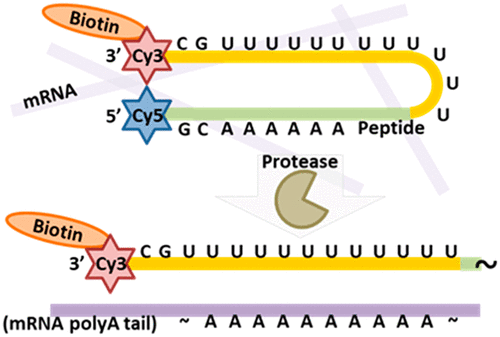当前位置:
X-MOL 学术
›
Bioconjugate Chem.
›
论文详情
Our official English website, www.x-mol.net, welcomes your feedback! (Note: you will need to create a separate account there.)
Caspase-Activated Oligonucleotide Probe.
Bioconjugate Chemistry ( IF 4.7 ) Pub Date : 2020-08-07 , DOI: 10.1021/acs.bioconjchem.0c00362 Linlin Yang 1 , James H Eberwine 2 , Ivan J Dmochowski 1
Bioconjugate Chemistry ( IF 4.7 ) Pub Date : 2020-08-07 , DOI: 10.1021/acs.bioconjchem.0c00362 Linlin Yang 1 , James H Eberwine 2 , Ivan J Dmochowski 1
Affiliation

|
Light-activated (“caged”) oligonucleotides provide a strategy for modulating the activity of antisense oligos, siRNA, miRNA, aptamers, DNAzymes, and mRNA-capturing probes with high spatiotemporal resolution. However, the near-UV and visible wavelengths that promote these bond-breaking reactions poorly penetrate living tissue, which limits some biological applications. To address this issue, we describe the first example of a protease-activated oligonucleotide probe, capable of reporting on caspase-3 during cellular apoptosis. The 2′-F RNA-peptide substrate-peptide nucleic acid (PNA) hairpin structure was generated in 30% yield in a single bioconjugation step.
中文翻译:

Caspase 激活的寡核苷酸探针。
光激活(“笼养”)寡核苷酸提供了一种策略,用于调节具有高时空分辨率的反义寡核苷酸、siRNA、miRNA、适体、DNAzyme 和 mRNA 捕获探针的活性。然而,促进这些键断裂反应的近紫外线和可见光波长很难穿透活组织,这限制了一些生物应用。为了解决这个问题,我们描述了蛋白酶激活的寡核苷酸探针的第一个例子,能够在细胞凋亡过程中报告 caspase-3。2'-F RNA-肽底物-肽核酸 (PNA) 发夹结构在单个生物偶联步骤中以 30% 的产率生成。
更新日期:2020-09-16
中文翻译:

Caspase 激活的寡核苷酸探针。
光激活(“笼养”)寡核苷酸提供了一种策略,用于调节具有高时空分辨率的反义寡核苷酸、siRNA、miRNA、适体、DNAzyme 和 mRNA 捕获探针的活性。然而,促进这些键断裂反应的近紫外线和可见光波长很难穿透活组织,这限制了一些生物应用。为了解决这个问题,我们描述了蛋白酶激活的寡核苷酸探针的第一个例子,能够在细胞凋亡过程中报告 caspase-3。2'-F RNA-肽底物-肽核酸 (PNA) 发夹结构在单个生物偶联步骤中以 30% 的产率生成。



























 京公网安备 11010802027423号
京公网安备 11010802027423号